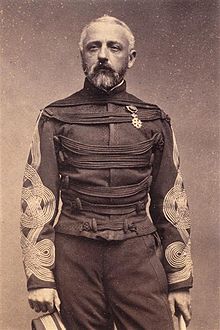Austrian knot
This article needs additional citations for verification. (April 2017) |


An Austrian knot (or Hungarian knot), alternatively warrior's knot or vitézkötés, is an elaborate design of twisted cord or
History
Of Hungarian origin, the vitézkötés (in English "warrior's knot") evolved as an indicator of rank among hussars of the Hungarian army, and became part of the Hungarian noble attire since the 16th century. Later, as other nations added hussars to their armies, they started to use the knot as well. The reason for this was that hussar regiments were often established by Hungarian nobles and some retained the name of their founder; for example the Ladislas Ignace de Bercheny.
In the Austrian (later
Austrian knots soon appeared as part of the distinctive uniform of hussar regiments in the armies of other European nations but did not gain wider popularity until the last decades of the nineteenth century. First the French army, then the Dutch,
Along with most other elaborate and conspicuous indicators of rank, Austrian knots fell into disuse during the
United States usage
During the
See also
- Frog (fastening) – decorative fastener which originated from China and was adopted in the military clothing of Western countries.
References
- ISBN 0-684-16304-7.
- ISBN 4-499-22737-2.
- ISBN 1-85532-371-0.
- ^ Encyclopædia Britannica, Eleventh Edition, page 585, Vol. 27
